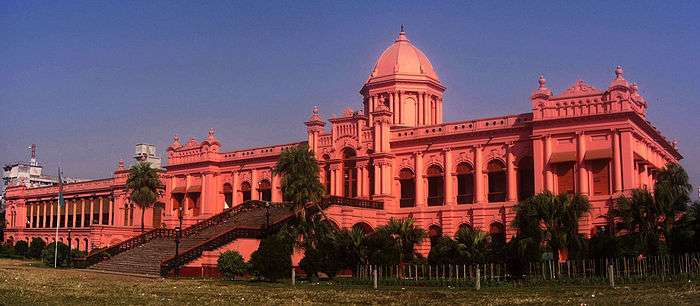Chakma Circle
The Chakma Circle (Burmese: သက်ထောင်), also known as the Chakma Raj, is one of three hereditary chiefdoms (or "circles") in the Chittagong Hill Tracts of modern-day Bangladesh.[1] The Chakma Circle encompasses parts of Rangamati Hill District and Dighinala and Rajasthali Upazilas in neighbouring Khagrachari District and Bandarban District respectively. The chiefdom's members are of Chakma descent.
| Part of a series on |
| Zamindars of Bengal |
|---|
 |
|
Central Bengal Present Divisions: Dhaka and Mymensingh
|
|
Eastern Bengal Present Divisions: Chittagong and Sylhet
|
|
Present Divisions: Rangpur and Rajshahi
|
|
|
|
|
Leadership
The Chakma Circle is led by a hereditary chieftain called a "raja," whose role encompasses judicial, administrative, ceremonial, legal and social responsibilities. Political power is passed from the father to the first-born son.[2]
The incumbent chieftain is Devasish Roy (b. 10 April 1959), according to the Chakma Bijok, a compilation of the Chakma history (1876-1934 CE). The Chakma chieftain also sits on the Advisory Council for the Ministry of Chittagong Hill Tracts Affairs and the Bandarban Hill District Council.[3] The Chakma chieftain leads a "rajpunnah" festival.[4]
History
Pre-colonial era
The lineage of Chakma chieftains may date to the 11th century or mid-16th century.[5] Chakma folklore and tradition ascribe the Chakma origins to the warrior castes of Bhagalpur in modern-day India.[6] The legendary raja Bijoy Giri (c. 1630), who is believed to have migrated the ancestors of the Chakma people north of the Naf River.[7] Through intermarriages with the Rakhine people, the Chakmas eventually converted to Buddhism.[7] Extant historical records date to the 1700s. Following the expansion of the Mughal Empire into Chakma territory, Chakma chieftains adopted Muslim names and titles (e.g., Khan) in exchange for tributary payments.[6][8]
British rule and modern era
During British rule, the Chittagong Hill Tracts were administratively divided into three circles in 1884, namely the Chakma Circle, the Bohmong Circle, and the Mong Circles, each presided over by a hereditary chief from the Chakma and Marma peoples.[7][9] The circles were codified into law with the Chittagong Hill Tracts Regulations, 1900, which eased revenue collection and administrative burdens on British authorities by delegating tax collection, land administration management and social arbitration responsibilities to the chieftains.[9][10] In 1901, the Bohmong Circle extended 2,421 square miles (6,270 km2).[11] This administrative structure remained in place until 1964, when the introduction of local self-government abolished the special status of these circles and brought local administration under the control of the central government.[12]
List of leaders
1. Shakya 2. Sudhanya 3. Langal Dhan 4. Kshudrajit 5. Samudrajit 6. Shyamal 7. Champakali 8. Sadang Giri 9. Chengyasur 10. Chandsur 11. Sumesur 12. Bhimanjoy 14. Sambuddha 15. Udaigiri 16. Bijoygiri 17. Shakalia 18. Manikbi 19. Manikgiri 20. Madalia 21. Kamal Chega 22. Ratan Giri 23. Kala Thongza 24. Sher Matya 25. Arunjug 26. Chanda Thongza 27. Moisang 28. Manikya 29. Kadam Thongza 30. Tin Sureswari 31. Janu 32. Rani Janu 33. Sathua 34. Dhabana 35. Dharamya 36. Mogalya 37. Jubal Khan 38. Fateh Khan 39. Sher Must Khan 40. Shukdev Roy 41. Sher Daulat Khan 42. Jan Bux Khan (1787-1800) 43. Tabbar Khan (1800-1801) 44. Jabbar Khan (1801-1812) 45. Dharam Bux Khan (1812-1832) Manager-Shuklal Dewan 46. Kalindi Rani (1832-1873 47. Harish Chandra Rai Bahadur (1873-1885) 47A. Court of Wards (Nil Chandra Dewan & Trilochan Dewan) (1885-1897) 48. Bhuvan Mohan Roy (1897-1934) 49. Nalinaksha Roy (1934-1951) 50. Tridev Roy (1951-1971) 50A. Samit Roy [Regent](1971-1977) 51. Devashish Roy (1977-present)
References
- Deakin, Liz; Kshatriya, Mrigesh; Sunderland, Terry (2016). Agrarian change in tropical landscapes. CIFOR. p. 194. ISBN 9786023870226.
- Ahmed, Kawser (2010). "Defining 'Indigenous' in Bangladesh: International Law in Domestic Context". International Journal on Minority and Group Rights. 17 (1): 47–73. doi:10.1163/157181110X12595859744169. JSTOR 24675834.
- "Chittagong Hill Tracts Peace Accord" (PDF). 1997-12-02.
- "Rajpunnah in Bandarban today". The Daily Star. 2009-02-04. Retrieved 2018-09-19.
- Dowlah, Caf (October 2013). "Jumma insurgency in Chittagong Hills Tracts: how serious is the threat to Bangladesh's national integration and what can be done?". Small Wars & Insurgencies. 24 (5): 773–794. doi:10.1080/09592318.2013.866419. ISSN 0959-2318.
- Serajuddin, A. M.; Buller, John (1984). "The Chakma Tribe of the Chittagong Hill Tracts in the 18th Century". Journal of the Royal Asiatic Society of Great Britain and Ireland (1): 90–98. JSTOR 25211628.
- Hutchinson, Robert Henry Sneyd (1906). An Account of the Chittagong Hill Tracts. Bengal Secretariat Book Depot. p. xvii.
- Jhala, Angma D. (January 2013). "Daughters of the Hills: legacies of colonialism, nationalism and religious communalism in the Chakma Raj family, Chittagong Hill Tracts, Bengal c. 1900–1972". South Asian History and Culture. 4 (1): 107–125. doi:10.1080/19472498.2012.750460. ISSN 1947-2498.
- Kundu, Debasish; Samadder, Mrinmoy; Khan, Ashrafuzzaman; Shajahan Naomi, Sharin (January 2011). State of Justice in Chittagong Hill Tracts: Exploring the Formal and Informal Justice Institutions of Indigenous Communities (Report). BRAC.
- "Bandarban wears festive look as Rajpunyah starts". The Daily Star. 2010-01-15. Retrieved 2018-09-19.
- Hutchinson, Robert Henry Sneyd (1906). An Account of the Chittagong Hill Tracts. Bengal Secretariat Book Depot. p. 122.
- Zaman, M. Q. (16 January 1982). "Crisis in Chittagong Hill Tracts: Ethnicity and Integration". Economic and Political Weekly. 17 (3): 75–80. JSTOR 4370578.